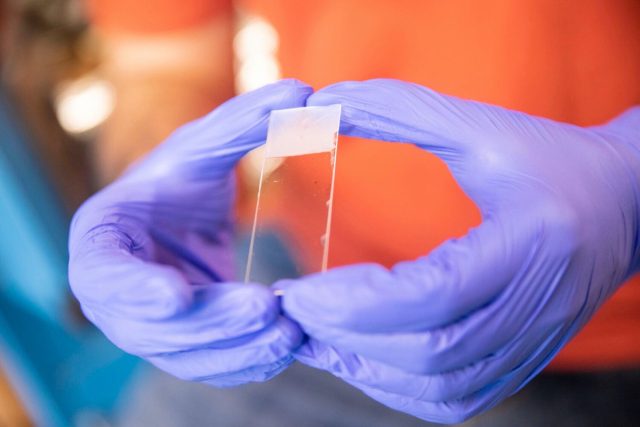Harvard researchers have developed a data-storage approach based on mixtures of fluorescent dyes that are printed onto an epoxy surface in tiny spots. The mixture of dyes at each spot encodes information that is then read with a fluorescent microscope.
Optical disks, flash drives, and magnetic hard disk drives can only store digital information for a few decades, and they tend to require a lot of energy to maintain, making these methods less than ideal for long-term data storage. So researchers have been looking into using molecules as alternatives, most notably in DNA data storage. Those methods come with their own challenges, however, including high synthesis costs and slow read and write rates.
Now, Harvard University scientists have figured out how to use fluorescent dyes as bits for a cheaper, faster means of data storage, according to a new paper published in the journal ACS Central Science. The researchers tested their method by storing one of 19th-century physicist Michael Faraday’s seminal papers on electromagnetism and chemistry, as well as a JPEG image of Faraday.
“This method could provide access to archival data storage at a low cost,” said co-author Amit A. Nagarkar, who conducted the research as a postdoctoral fellow in George Whitesides’ Harvard lab. “[It] provides access to long-term data storage using existing commercial technologies—inkjet printing and fluorescence microscopy.” Nagarkar is now working for a startup company that wants to commercialize the method.

Enlarge / Amit Nagarkar helped develop a data-storage system that uses fluorescent dyes while a postdoc in George Whitesides’ lab at Harvard University.
Kris Snibbe/Harvard Staff
There’s good reason for all the interest in using DNA for data storage. As we’ve reported previously, DNA has four chemical building blocks—adenine (A), thymine (T), guanine (G), and cytosine (C)—which constitute a type of code. Information can be stored in DNA by converting the data from binary code to a base-4 code and assigning it one of the four letters. DNA has significantly higher data density than conventional storage systems. A single gram can represent nearly 1 billion terabytes (1 zettabyte) of data. And it’s a robust medium: the stored data can be preserved for long periods of time—decades, or even centuries.
DNA data storage has progressed noticeably in recent years, leading to some inventive twists on the basic method. For instance, two years ago, scientists successfully fabricated a 3D-printed version of the Stanford bunny—a common test model in 3D computer graphics—that stored the printing instructions to reproduce the bunny. The bunny holds about 100 kilobytes of data, thanks to the addition of DNA-containing nanobeads to the plastic used to 3D print it.
But using DNA also presents imposing challenges. For instance, storing and retrieving data from DNA usually takes a significant amount of time, given all the sequencing required. And our ability to synthesize DNA still has a long way to go before it becomes a practical data-storage medium. So other scientists have explored the possibility of using nonbiological polymers for molecular data storage, decoding (or reading) the stored information by sequencing the polymers with tandem mass spectrometry. However, synthesizing and purifying the synthetic polymers is a costly, complicated, and time-consuming process.

Enlarge / Nagarkar displays tiny dye molecules used to store information.
Kris Snibbe/Harvard Staff
In 2019, Whitesides’ lab successfully demonstrated the storage of information in a mixture of commercially available oligopeptides on a metal surface, with no need for time-consuming and expensive synthesis techniques. The lab used a mass spectrometer to distinguish between the molecules by their molecular weight to read the stored information. But there were still some issues, most notably that the information was destroyed during the readout. Also, the readout process was slow (10 bits per second), and scaling down the size proved problematic, since decreasing the laser spot size resulted in an increase in noise in the data.
So Nagarkar et al. decided to look into molecules that could be distinguished optically rather than by molecular weight. Specifically, they chose seven commercially available fluorescent dyes of different colors. To “write” the information, the team used an inkjet printer to deposit solutions of mixed fluorescent dyes onto an epoxy substrate containing certain reactive amino groups. The subsequent reaction forms stable amide bonds, effectively locking the information in place.

